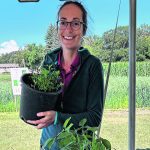‘Honeymoon’ period for producers is ending as diseases such as phytophthora root rot make inroads following soybean expansion
Glacier FarmMedia – The worst phytophthora infection that Laura Schmidt of Manitoba Pulse and Soybean Growers has ever seen was just south of Souris. “Probably 25 per cent of the field was impacted,” the production specialist told field day attendees at the Westman Agricultural Diversification Organization near Melita. “One in four plants were dying off, […] Read moreTag Archives crop disease

Verticillium stripe in spotlight as threat grows
A U of A study just wrapped up, and four Canola Agronomic Research Program projects are now investigating the disease
Glacier FarmMedia – If you’re a canola grower on the Prairies, you know there are no chemical solutions or varieties to kill or resist soil-borne verticillium stripe disease. You may also know the handful of management practices that can thwart the disease to some extent. And if a crop has been damaged by it, you […] Read more
Disease roundup: Verticillium has breakout year
Plant pathologists are still sorting through the data, but 2023 may become the year that verticillium stripe emerged a major problem for canola growers in Western Canada. In 2022, Saskatchewan Agriculture staff discovered verticillium is a common disease in the eastern part of the province. In the fall of 2023, producers in other parts of […] Read more

Bacterial leaf streak disease persists; Alta. crops affected
The disease has caused economic yield losses in a small number of fields, but its presence could become a lingering issue for cereal growers
Bacterial leaf streak is not going away. The disease was present this summer in possibly “hundreds” of irrigated fields of barley, durum and spring wheat in southern Alberta, said Mike Harding, a plant pathologist with Alberta Agriculture. The disease caused economic yield losses in a small number of fields, but its presence could become a […] Read more
Farmers watch as verticillium extends its reach in Sask.
The canola disease appears to be moving west and north after being found in eastern part of the province last year
Anecdotal evidence suggests that verticillium is moving north and west across Saskatchewan. In 2022, Saskatchewan Agriculture staff discovered that verticillium stripe, a disease of canola, was commonplace in the eastern part of the province. This fall, producers in other regions have found the disease in their canola. “I’ve got verticillium in Davidson like you wouldn’t […] Read more
Verticillium spreads in Saskatchewan
Anecdotal evidence suggests that verticillium is moving north and west across Saskatchewan. In 2022, Saskatchewan Agriculture staff discovered that verticillium stripe, a disease of canola, was commonplace in the eastern part of the province. This fall, producers in other regions have found the disease in their canola. “I’ve got verticillium in Davidson like you wouldn’t […] Read more

Disease survey finds elevated aster yellows levels in Manitoba
Clubroot levels in the province stay low, but a field near Roblin is highly infected with the soil-borne disease
Aster yellows likely reduced canola yields in some Manitoba fields this fall, as the disease was five times more common in 2023 than it was last year. Manitoba Agriculture plant pathologist David Kaminski released preliminary results of the annual canola disease survey for the province during a presentation in early September. About 20 percent of […] Read more
Wild varieties may hold disease resistance key
Wild cousins of domesticated crops may hold the key to new genetic traits that could help crops thrive in various conditions or stave off diseases and insect pests.Sabine Banniza is a professor at the University of Saskatchewan where she holds the Ministry of Agriculture Strategic Research Program (SRP) Chair in Pulse Crop Pathology. She has […] Read more

Crop Diagnostic School held in Manitoba
The event is designed to refine the diagnostic skills of farmers and agronomists involved in field scouting and assessing crop health. This year, there were sessions on diseases, insects, weeds and soils.

High-tech CGC lab aids farmers in disease fight
Canadian Grain Commission facility focuses on quick analysis as it aims to identify crop disease at the microscopic level
In the Canadian Grain Commission’s laboratories, the rapid evolution of technology is allowing scientists to spot, catch and exactly identify specific strains of diseases like fusarium, the toxins they produce and many other threats to grain quality and safety.



